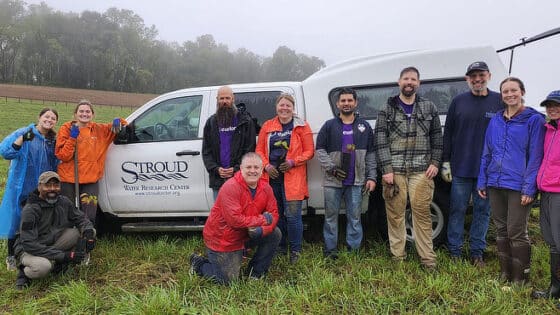FOR IMMEDIATE RELEASE: February 8, 2011
CONTACT: Diane Huskinson, Stroud Water Research Center
Avondale, Pa. – This February, scientists at the Pennsylvania-based Stroud Water Research Center take the world stage once again with another groundbreaking study on the Stroud Center’s focus — fresh water. This new study, made possible with a Long-Term Research in Environmental Biology (LTREB) grant from the National Science Foundation (NSF), will investigate how the ecology of a stream changes as trees planted along the stream banks mature.
Grant funding will allow Stroud Water Research Center scientists to build on over 40 years of data and use cutting-edge technologies to collect new data on everything from the shape of the stream channel of southeastern Pennsylvania’s White Clay Creek (WCC) to the food resources of the insects and fish living in the stream.
“The grant represents the combined efforts of all research fields at the Stroud Center and builds on the collaborative science that is a hallmark of our organization,” said Dr. Louis A. Kaplan, senior research scientist at the Stroud Center and the grant’s project director.
Restoration of the stream began in 1967 when the Stroud Center was established in a pasture next to WCC and cattle that had been trampling the stream banks were removed. The Stroud Center began a complete restoration and reforestation of the riparian zone in the mid-1980s with the planting of native deciduous trees and removal of invasive plant species. As the forest has grown, Center scientists used prior LTREB funding to characterize the sequence of changes in the physical, chemical, and biological attributes of the stream; this new grant will extend those studies as the forest matures.
“We have known for years that the reforestation of stream banks is perhaps the single most important step that can be taken to improve water quality and stream health,” said Kaplan. “What we do not know is the sequence of events or time frames needed to reach certain milestones along a stream restoration trajectory.”
A study of the long-term impacts on streams after landscape restoration has never been done before. The grant will provide the needed funding to do so.
“Understanding how the health of a stream changes over time following reforestation will provide much needed information and guidance for the billion-dollar-a-year stream restoration industry, government agencies that regulate the projects, and taxpayers who often fund the projects,” said Kaplan.
The Stroud Center will publish project data on the Web, and the Stroud Center’s education department will use that data to help middle- and high-school science teachers incorporate the use of long-term, environmental data into the classroom to enhance students’ science skills and environmental knowledge.
Over the last 10 years, the Stroud Center has worked with over 22,500 students and 3,200 teachers. The new five-year grant will allow the Stroud Center to reach even more.
“Our programs strive not only to make the Stroud Center science accessible to diverse audiences,” said Kaplan, “but to connect people to their own watersheds and promote stewardship.”
In 1981 NSF designated the Stroud Center an Experimental Ecological Reserve and, in 1998, an LTREB site for its dedication to long-term experimental research on an ecosystem that is an outstanding representative of its type. The Stroud Center sits along the banks of WCC, a Pennsylvania-designated exceptional value watershed and a part of the National Wild and Scenic Rivers system.



